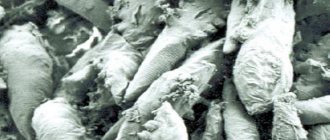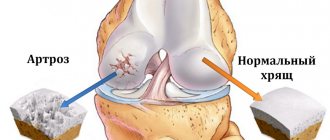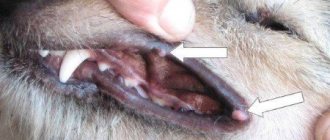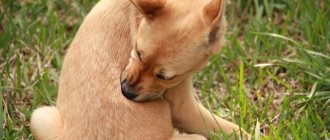What is demodicosis and who is the causative agent of the disease?
Demodicosis in dogs is a parasitic disease caused by a special form of the scabies mite Demodex Canis, which lives exclusively on dogs.
Both animals and people can suffer from demodicosis. But the possibility of transmitting the disease to humans from dogs and vice versa is excluded. The fact is that the causative agent of the disease in humans is one type of parasite (Demodex folliculorum), and in dogs it is another.
Demodex Canis is a small mite that can only be seen under a microscope. Adults reach only 0.4 mm in length. A translucent elongated body, short legs and a very powerful (so to speak) jaw apparatus for such a microscopic parasite.
The mite settles in the animal's hair follicles or in the sebaceous and sweat glands located near the hair shaft. There are the best conditions for him there. Thanks to the scales located on the body, it is perfectly anchored in its “den”. Having eaten the contents of the hair follicle, the adult mite moves to the next source of “food”, gnawing its way and eating away epithelial cells, delivering a lot of unpleasant sensations to its “owner”.
Hence the animal’s characteristic signs of the disease: constant itching and hair loss. The gnawed “tunnel” is filled with intercellular fluid, which is excellent for the appearance of bacteria. That is why the disease demodicosis is often additionally accompanied by bacterial infections.
Adults lay eggs in their habitats, and within a month they grow into mature ticks. One hair follicle can simultaneously contain a whole colony of parasites - up to 5 thousand mites of varying degrees of development. Adults feed on the contents of hair follicles and sebaceous glands. And the larvae eat the dead cells.
When there are a lot of parasites, in search of “food” they make their way deeper and deeper. If treatment is not started in time, mite colonies penetrate the dog’s liver, kidneys, lymph nodes and other internal organs.
With such complex forms of demodicosis, the animal either can no longer be treated, or, after long and difficult therapy, suffers from the consequences of this terrible disease for the rest of its life.
Treatment of demodicosis in dogs
Others have an optimistic point of view and believe that a complete recovery is only possible if the dog was initially prescribed the correct medications and procedures.
It is believed that if this tick has not returned eight months after the previous treatment, then the pet has finally recovered.
When a pet and its owner encounter this parasite, it is very important to choose a professional and experienced veterinarian, since the life of your four-legged friend will be in his hands. The more competent the doctor is and the more correct the treatment he prescribes, the greater the dog’s chances of a happy and long life.
Treatment of the disease, which is caused by Demodex Canis mites, is carried out comprehensively, covering several types and types of medications. The fact is that some of them affect only the larvae that live in the upper layers of the skin and absorb dead epidermal cells, while other drugs penetrate only living cells to destroy the virus inside.
In addition to medications that kill bacteria, the veterinarian should prescribe medications that help strengthen the immune system. If the stage of the disease is advanced and fungal inflammation has been added to the main problem, then antibiotics will also be prescribed.
Medicines to kill Demodex Canis
As was written above, there is no medicine yet that would cover all aspects of the disease. That is why, after diagnosing demodicosis, a number of drugs and procedures are prescribed that will jointly rid the pet of this parasite.
Injections
- Aversect K&S. For treatment, 0.2% and 0.5% injection solutions are used. Different dosages are used for different weights. For small dogs weighing less than 10 kilograms, a sufficient dose of 0.1 milliliter of 0.2% solution per kilogram of weight is sufficient. For large dogs weighing over 10 kilograms, take 0.4 milliliters of a 0.5% solution for every ten kilograms of weight.
Such injections are administered once every six days until the animal recovers. Every 3 weeks you need to take a soscope for tests. After the third negative result, the injections are stopped.
- Ivermectin. This drug is presented on the drug market in three versions: injections, cream and tablets. A one-percent solution administered intramuscularly and once will kill parasites. Dosage: 0.1 milliliter for every five kilograms of weight. This medicine has contraindications. It is not allowed for dogs that are under six months old, dogs that are expecting offspring and are involved in the feeding process.
Pills
- "Ivermectin." Packaged in tablets of 3 milligrams. The drug is not recommended for dogs under one year of age.
- "Milbemycin". Country of origin: France. This remedy is prescribed by a veterinarian.
- "Bravecto". A drug that, 12 hours after administration, can kill all parasites. This remedy is contraindicated for small pets up to two kilograms.
Ointments
- Sulfuric ointment. An anti-inflammatory drug that is applied to infected areas and the surface of the skin around them. Kills larvae, eggs and parasites themselves.
- Ichthyol ointment. This ointment has analgesic and anti-inflammatory properties. After you have applied the ointment, you need to cover it with a gauze bandage on top.
- "Vetabiol". Used as a wound healing agent.
- Aversectin ointment. This remedy is also good at killing adult parasites, as well as larvae in the epidermis. Contraindicated in nursing dogs, pregnant women and pets with loss of strength.
Solutions for treating affected skin areas
- Chlorhexidine. A solution that is universal in its scope of application. Typically used to cleanse a wound before applying ointment.
- "Bars Spot". It is used specifically for demodicosis. Not recommended for use on puppies under 2 months of age.
Shampoos
- "Phytoelite". Removes itching and irritation.
- "Doctor". Reduces inflammation and itching. Helps in eliminating germs.
Skin restoration
This disease leaves behind unpleasant complications on the animal’s body: hairless areas, irritated areas. The following ointments will help to cope with this: Levomekol, pharmacoid and ichthyol.
Detoxification
Since internal organs are often also exposed to the harmful effects of bacteria, after getting rid of parasites, the animal’s body needs to be cleaned. For this we recommend: “Karsil”, “Phytoelita” product. Healthy kidneys", "Essentiale forte".
Immunity restoration
All attention must be concentrated on the proper nutrition of the dog. Good nutrition will already be an excellent help in the fight against parasites. To improve bowel function, it is recommended to take probiotics. As means to maintain immunity, veterinarians prescribe: “Immunofan”, “Hemobalance”, “Fosprenil”.
What contributes to the manifestation of demodicosis
As a result of veterinary studies, it was found that Demodex Canis is part of the normal skin fauna of tetrapods. Therefore, when taking a skin scraping, it is often found in completely healthy animals.
A tick can live on a dog’s skin all its life without causing illness or causing any inconvenience to its “carrier.” But, as a result of some external or immune changes, the parasite can wake up from hibernation. Its numbers increase sharply, which leads to a condition called demodicosis.
The following factors can contribute to the manifestation of demodicosis as a disease:
- Age. The disease usually affects young dogs under one year old and older pets over 10 years old. The reason for this is the immature immunity of young animals or the weakened immunity of older dogs due to age.
- Heredity. Often the disease can be inherited from the mother to puppies.
- Seasonality. Most often, demodicosis occurs in dogs between April and September. This is due to warm weather, which is favorable for the growth of Demodex Canis. During this period, the development cycle of the parasite is halved. Instead of 3-4 weeks, the tick turns into an adult in 2 weeks. During the warm summer period, the female manages to lay thousands of eggs, which complicates the treatment of the disease.
- Stress. Constant tension caused by one reason or another primarily has a negative impact on the psychological state of the animal and its health. All internal systems of the body are under attack: the gastrointestinal tract, cardiovascular and endocrine systems. A weakened body can no longer resist the influence of external factors. As a result, the slightest contact with an infection or virus immediately leads to the development of a serious illness.
- Poor nutrition. If dogs are fed improperly, the functioning of the gastrointestinal tract and liver is disrupted. This leads to the development of skin diseases such as psoriasis, dermatosis and so on. Alopecia (hair loss) appears on the skin, which is easily “settled” by fungi and mites. In addition, poor nutrition leads to malfunction of internal organs, which weakens the body and reduces immunity.
- Weak immunity. This is the main reason for the development of demodicosis. And, one might say, a collective factor. All of the reasons described above contribute to weakening of the immune system: housing, improper feeding, stress, tumors, prolonged exposure to medications, helminths, lack of proper care, contact with sick animals and much more.
- Lack of proper care. The likelihood of infection with demodicosis is high in the absence of normal animal care: poor hygiene, poor nutrition, untimely deworming and vaccination, self-walking and communication with stray dogs.
- Contact with a sick animal. If your pet's immunity is weakened, then any contact with a sick animal will most likely lead to infection.
Examination of skin scrapings
Skin scrapings are used in dermatology to diagnose parasitic skin lesions and dermatophytoses (“lichen”).
Diseases for which examination of skin scrapings may be informative:
- otodectosis - infection by ear mites, superficial scraping;
- notoedrosis - skin scabies of cats, superficial scraping;
- cheyletiellosis - “wandering dandruff”, superficial scraping;
- demodicosis - “ironworm”, demodectic scabies, deep scraping;
- sarcoptic mange - pruritic scabies, superficial scraping;
- dermatophytosis (“lichen”) is a fungal skin disease, superficial scraping. The scraping reveals spores and hyphae of the fungus, but its type can only be determined by inoculation on a nutrient medium in the laboratory.
Indications for taking scrapings are focal or extensive hairless areas, itching, dandruff, acne on the skin, increased oily skin or oily casts, interdigital furunculosis.
Young animals are predisposed to parasitic diseases, although they can occur at any age.
Deep skin scraping technique
A deep skin scraping is performed if demodicosis is suspected. The causative agent of demodicosis parasitizes the sebaceous glands of the skin at the border of the epidermis and dermis. Therefore, when taking a sample, you can gently press the skin with your fingers to squeeze out the mites. It is better to cut the wool first. The scraping area may be small; it is important to choose the right location.
A few drops of petroleum jelly or glycerin are applied to the prepared glass. The skin or scalpel blade should also be slightly moistened with oil. The scraping is made with a scalpel blade perpendicular to the surface of the skin and transferred to the glass. The criterion for the correctness of taking a deep scraping is the appearance of droplets of blood.
Technique for superficial skin scraping
First of all, you need to select a sampling location. Scraping should be done in areas of maximum likelihood of detecting a parasite - areas of baldness, inflamed or reddened skin, under accumulations of dandruff, in areas of scratching or areas of favorite localization of suspected parasites.
A superficial scraping is taken from a relatively large area of skin; long hair must first be trimmed and the skin moistened with oil. The material is taken superficially from a large area and transferred to the glass. For ease of viewing, you can cover the material on top with another glass.
Taking a superficial scraping from the kitten. This method allows you to identify cheyletella mites and dermatophytes.
Interpretation of skin scraping results
If all the rules for collecting material are followed, most parasites are easily detected in scrapings of the skin or contents of the ear canal. In doubtful cases, if demodicosis is suspected, hair plucking can be additionally used.
The absence of parasites in the material when otodectosis, cheyletiellosis, demodicosis, and notoedrosis is suspected makes it possible to exclude these diagnoses from the list of suspects with high certainty.
If sarcoptic mange is suspected, trial antiparasitic therapy is carried out even if the scraping results are negative, since mites may not be detected due to their small number.
For dermatophytosis, scraping is an auxiliary diagnostic method.
How does a tick spread?
Demodex Canis is transmitted through direct contact between animals in so-called zoozones. In these cases, the disease manifests itself precisely on those parts of the body with which the four-legged animals most actively contact each other. These are the muzzle, lips, ears, eyebrows, eyelids, chest and front legs.
The main difference between demodicosis and other diseases is that a healthy pet with a strong immune system is practically not susceptible to infection, even through direct contact with a sick dog. As a rule, pets with weak immune systems or four-legged animals with damaged skin are at risk.
Is it possible to help with folk remedies?
Traditional methods for the treatment of demodicosis:
- Tar soap. You can wash your pet with it 1-2 times a week. Use birch tar effectively.
- Juniper fruits. They should be mixed with sour apples. Pass through a grater and apply to affected areas.
- Celandine roots. Pour in vegetable oil so that the ratio is 1:1. Heat the mixture for 3-4 hours at a temperature of 50 degrees, strain thoroughly. Apply to damaged areas once a day.
For mild scabies or in the initial stages, folk methods are also effective:
- Garlic tincture. Chop the cloves, pour in almond oil in a ratio of 1 to 3. Leave for three days in a dark place. Apply to skin once daily. This vegetable can cause harm to your pet, so more frequent application is not allowed.
- Tincture of kefir and black sulfur. Mix sulfur and drink in a ratio of 1 to 3. Apply to affected areas once a day. This is no longer possible, as sulfur dries and burns the skin. You cannot keep the tincture on the skin for a long time - spread it on and wash it off immediately.
- Sulfuric ointment. This is a pharmaceutical product. Apply to skin twice a day, do not rinse. A burning sensation during processing may also be observed.
- Lavender oil. Apply to the skin and wait until it is absorbed. Then rub in chalk powder. Repeat 4-5 times a day.
Folk remedies are available and effective, but they should not be abused. They dry out the skin greatly, which leads to discomfort for the dog.
Video: subcutaneous mite in a dog: symptoms and treatment
Forms and symptoms of demodicosis
The first signs of the disease are visible only when the parasite is actively reproducing and has already formed entire colonies.
Depending on the course of the disease, there are three main forms of the disease. Let's start, so to speak, with the mildest degree of severity and work our way up.
Scaly (focal) form of demodicosis
The focal form is considered the mildest. The animal begins to itch intensely. On the skin around the eyes, nose, ears and neck area, redness and rounded hairless areas of skin appear, covered with small pityriasis-like scales of keratinized epidermis.
The skin in these areas is red and rough, sometimes with cracks and small nodules. The hair along the edges of such areas is sparse and very brittle.
At this stage, there are not many outbreaks: from three to five. Typically, bald areas of skin are located on the head, paws or chest.
The focal stage lasts 1-2 weeks. Next comes the pustular stage of manifestation of the disease.
Pustular demodicosis
Pustular demodicosis can develop as a complication of the scaly form, or independently. Dense nodules on the affected areas transform into red-brown and sometimes black pustules.
At 4-5 weeks from the onset of the disease, the pustules burst and pus is released from them, often mixed with blood. During laboratory examination, entire colonies of Demodex Canis can be found in such secretions at different stages of their development.
An unpleasant odor emanates from the affected areas. When the pustular mucus begins to dry out, a scab (a crust formed by blood, pus and dead pieces of epidermis) forms on the surface of the wound.
In the absence of proper treatment, the disease develops into the most complex - generalized form.
Generalized form
Generalized demodicosis in dogs is the most severe stage of the development of the disease. It is characterized by the same symptoms as in the first two cases. But, skin lesions become more extensive. If 5 or more bald spots appear on the animal’s body, experts diagnose the generalized form of demodicosis.
The boundaries of disease-affected areas are constantly increasing and “spreading.” The dog becomes like a sick dinosaur with inflamed areas of skin covered with scabs. A heavy fetid odor emanates from the four-legged creature. Without proper treatment, after 2-3 months, the animal becomes completely bald.
Having “eaten” the skin, Demodex Canis gradually moves further and affects the internal organs. The pet refuses to eat. Vomiting, convulsions, general weakness and loss of coordination appear. Exhaustion sets in and the animal dies.
There is a type of generalized form - this is generalized juvenile (children's) demodicosis. This form of the disease is considered hereditary and is transmitted from mother to puppies through a special autosomal recessive gene. Most often, puppies under one year of age are affected. Treating this form of the disease is very difficult and takes a long time. After recovery, such pets are sterilized.
Causative agent of demodicosis
Young animals (up to one year old) and short-haired breeds are most susceptible to infection with demodicosis. The pathogen enters the animal's body through infected household items or from an infected dog. A humid and warm environment is most suitable for the pathogen. In such conditions he can live for 2-3 weeks. This is enough for reproduction. Sweat and sebaceous glands, liver, spleen, hair follicles are the habitat of the tick. It is there that it forms entire colonies. Demodicosis is sometimes called a disease of stray dogs, but this is not true at all. A completely healthy, domestic dog can get sick. It is enough to have only a short period of contact with an infected individual. The incubation period lasts 4-6 weeks, followed by the primary signs of demodicosis.
Complications and consequences
Against the background of weakened immunity, demodicosis is almost always accompanied by fungal and microbial infections. This complicates the course of the disease. It takes more time, effort and medications to carry out complex treatment.
In addition, demodicosis may be accompanied by conjunctivitis and dermatitis.
In the generalized course of the disease, damage to the gastrointestinal tract and liver may occur, and problems with the endocrine system may arise.
Diagnostics
It is quite easy to identify demodicosis in dogs. Clinical symptoms are quite characteristic of this particular disease.
In addition to the characteristic external signs, for an accurate diagnosis, an additional deep scraping is taken from the affected areas of the skin. In order for more ticks to come out, the skin is squeezed and scraped so deeply that droplets of blood appear. In the complicated form of demodicosis, mites are found in entire colonies: with eggs and larvae.
Demodex Canis under a microscope
If demodicosis is at the initial stage, and the clinical picture is quite typical for this disease, and no mites are found in the material taken by scraping, the scraping is repeated in another affected area.
In addition, to make a correct diagnosis, a study of heredity is carried out. If these are very small puppies, then the analysis is also taken from the mother dog.
Treatment
For local demodicosis, you can get by with ointments. The most popular is aversectin gel 0.05%. It is applied to the affected areas several times until the inflammation completely disappears. Along the way, the animal is bathed with shampoo containing benzoyl peroxide. A month after the start of treatment, a follow-up examination by a veterinarian and a test are carried out. It is better to keep the dog in the house during all therapy, not allow him to communicate with other animals, and only walk him a little and separately from people and dogs. Demodectic mange in dogs can be treated well at home at the initial stage. In case of a generalized form, the veterinarian will select a stronger remedy and prescribe an individual treatment regimen.
Amitraz
It is recommended to use a 0.025% aqueous solution. It is applied to affected and healthy areas of the skin. Before this, the animal is cut short and the scabs are removed. Immediately before the procedure, the dog is bathed with medicated shampoo. Then Amitraz is distributed over the entire surface. The procedure is repeated after 1-2 weeks on the recommendation of a doctor.
Advocate
Advocate Bayer pipettes require long-term use. Most often, they are applied to the animal’s withers once a month, and the course of therapy lasts up to 4 months. If the disease is detected late, the veterinarian may initially prescribe weekly use of the drug. According to research, results with this scheme are achieved faster.
Ivermectin
This medication works best in injection form. A 1% solution of Ivermectin causes instant paralysis of all ticks, regardless of their stage of development. The injection is administered once at a rate of 0.1 ml per 5 kg of weight. If the case is advanced, then re-appointment is possible only after 7-10 days. The drug is strictly prescribed by a veterinarian, since for some breeds of dogs it is toxic and can cause severe disturbances in the functioning of the liver and other organs.
There are also Ivermectin tablets, which are given only to adult dogs at a rate of 200 mg per kg of weight. The duration of therapy is selected by the doctor depending on the degree of damage.
Other drugs
To recover, the animal will have to undergo a long course of therapy. Along the way, the owner must not forget about hygiene - treat the affected areas with a Chlorhexidine solution or wash the dog with a shampoo prescribed by the doctor (Doctor, Fitoelita, etc.). They will kill bacteria on the surface and also relieve itching.
Demodectic mange in dogs, symptoms and treatment may require additional use of ointments:
- Sulfur – works not only against sexually mature individuals, but also their larvae. The ointment should be applied twice a day to the lesions and surrounding areas.
- Vetabiol – helps get rid of bacteria, has an anti-inflammatory and wound-healing effect. The duration of therapy is 14 days, use 2-3 times a day on scratches and scabs.
- Ichthyol ointment will help relieve pain and itching, relieve inflammation, plus it will work as an antiseptic. The animal's wounds are lubricated with it every 8-10 hours.
In addition to ointments, Aversect K&S injections (0.2% or 0.5%) have worked well. For 10 kg of animal weight, take 0.4 ml of a 0.5% solution, if the dog is large. If his weight does not even reach the 10 kg mark, then choose a dosage of 0.2% - 1 ml/kg of weight.
Of the tablets, Milbemycin has proven itself well. It is effective in combating various types of worms, including demodex mites. Another drug is Bravecto. The tablets are available in five dosages, the choice depends on the weight of the dog, and is prescribed only by a doctor. They work quickly, and within 24 hours all parasites will be destroyed. If the dog weighs less than 2 kg or is a puppy, then giving tablets is contraindicated.
They are given to the dog to chew before eating. The tablet cannot be crushed or divided, since different parts contain different components. Inside the body, they must work simultaneously and it is important that the pet eats the entire tablet at once.
Treatment of demodicosis in dogs
There are two opinions from veterinary specialists regarding a complete cure for demodicosis. Some believe that a complete cure is impossible: if there is a tendency to the disease, then sooner or later it will flare up again. Others are optimistic and claim that if you choose the right medications and strictly follow all the veterinarian’s recommendations, you can completely get rid of the disease.
In any case, the animal is considered completely healthy if, eight months after treatment, the disease has not flared up again.
Demodicosis in dogs is a serious disease that is difficult to treat. The choice of treatment method depends entirely on the degree of damage to the animal’s body. Therefore, it is very important to find a competent veterinarian who will prescribe medical procedures based on the condition of a particular animal.
The fight against Demodex Canis is carried out in a comprehensive manner and includes several types of drugs of various types. Therapy is complicated by the fact that some drugs penetrate only living cells of the body and act only on adult individuals, which live exclusively in living tissues. The action of other drugs is aimed at destroying the larvae that live in the upper layers of the epidermis and feed on dead cells.
In addition to medications aimed at destroying Demodex Canis, the doctor prescribes medications to restore immunity, remove toxins and restore affected skin.
If the disease is accompanied by fungal infections, in addition to the main medications, antibiotics are prescribed.
All the drugs described below are presented for informational purposes as possible drugs for the treatment of demodicosis. The combination and treatment regimen should only be prescribed by a veterinarian after conducting a comprehensive examination of the pet’s condition.
Medicines to kill Demodex Canis
Injections
- Aversect K&S - 0.2% or 0.5% solution for injection. For large and medium-sized dogs, apply in the proportion of 0.4 ml of 0.5% solution for every 10 kg of weight. For dogs weighing less than 10 kg, apply in the proportion of 0.1 ml of 0.2% solution per 1 kg of body weight. Injections are administered once every 6 days until complete healing. The course of treatment is quite long and is prescribed by a veterinarian based on the condition of the sick animal. Scrapings must be performed once every 3-4 weeks. This drug is used until 3 negative scraping results are obtained.
- Ivermectin is available as an injection, tablet, or cream. Ivermectin for injection is a 1% solution that causes paralysis and then death of ticks and larvae. The therapeutic effect occurs very quickly. It is administered once, intramuscularly. Dosage: 0.1 ml for every 5 kg of quadruped weight. In case of advanced demodicosis, the injection is repeated after 7-10 days. Ivermek is contraindicated in weakened animals, puppies under 6 months, pregnant and lactating bitches. It is prescribed with caution to dogs of the following breeds: sheltie, collie and bobtail due to breed intolerance to the drug.
Pills
- Ivermectin is available in 3 mg packages. For the treatment of adult dogs, an amount of 200 mcg per 1 kg of animal weight is used. This drug is not recommended for puppies. The duration and regimen of administration is prescribed by the veterinarian.
- Milbemycin is a French deworming drug that is also used to kill demodectic mites. Prescribed according to instructions.
- Bravecto. Chewable insectoacaricidal drug for the treatment and prevention of infection of animals by ticks, fleas and other parasites. Kills all “evil spirits” within 12 hours after administration. The main active ingredient is fluralaner (isoxazoline insecticide and acaricide of complex action). The tablets are produced in 5 different dosages, depending on the fluralaner content they contain. Prescribed in a dosage of 25-65 mg of active substance per 1 kg of dog weight. The tablet is given whole before meals. Bravecto should never be divided into parts, since one half of the tablet contains fluralaner and the other half contains excipients. If the dosage is not suitable, it is better to take two tablets with different contents of the active ingredient. Contraindication for use is individual intolerance. Also, the drug should not be given to puppies younger than 8 weeks and pets weighing less than 2 kg.
Ointments
- Sulfur ointment is a product for external use. It has anti-inflammatory and antimicrobial effects. It perfectly destroys not only parasites, but also larvae. Apply both to the affected areas and to the area around them. Apply 1-2 times a day.
- Aversectin ointment is an insectoacaricidal agent that destroys both larvae and adult mites living on the surface of the skin. For focal demodicosis, the ointment is applied to the wounds 3 times a day. Then a 5-7 day interval, and then the procedure is repeated again. For pustular and generalized forms, the ointment is applied 7 times per knock with an interval of 7 days. And so on until the pet’s complete recovery. Should not be used by weakened animals, pregnant or lactating bitches, or puppies under 2 months of age.
- Ichthyol ointment has antiseptic, anti-inflammatory and analgesic effects. Apply to wounds every 8-10 hours. A gauze bandage is applied over the applied layer of ointment.
- Vetabiol ointment has antimicrobial, anti-inflammatory and wound-healing effects. Apply to affected areas 2-3 times a day. The duration of treatment for demodicosis is 14 days.
Solutions for treating affected skin areas
- Bars Spot-on solution contains praziquantel, ivermectin and other excipients. Recommended for dogs older than 2 months for the prevention and treatment of nematoses, otodecosis and demodicosis. According to the instructions, the dosage of the drug is measured in pipettes and applied to the withers and spine in 3-4 places. The number of pipettes depends on the weight of the animal: from 2 to 5 kg - 1 pipette, from 5 to 10 kg - 2 pipettes, from 10 to 20 kg - 3 pipettes and so on. For the treatment of demodicosis, the drug is used at 14-day intervals until 2 negative scraping results are obtained.
- Chlorhexidine is a universal solution with a wide range of applications. It has antiseptic properties and is used to wash affected areas before applying medicinal ointments.
Shampoos
Many four-legged owners doubt the need to use shampoos. However, under the influence of shampoo, remnants of dead epidermis are removed from the affected areas, which allows for more effective treatment with antiparasitic ointments.
For complex treatment of demodicosis, veterinarians recommend:
- "Doctor" is an anti-itch shampoo based on benzoyl peroxide. It stops the growth of harmful microbes and helps reduce inflammatory processes.
- Shampoo "Phytoelita" with insecticidal effect. Relieves inflammation and itching, protects the four-legged from parasites.
Treatment of demodicosis with hormonal drugs (in particular corticosteroids) is strictly prohibited. These drugs contribute to the complication of the disease and the development of the disease into a purulent form.
Skin restoration
Demodicosis in dogs leaves severe marks on the body: redness, itching, hair loss. To restore the integrity of the skin, ointments such as Levomekol, Pharmaiodnaya and Ichthyol are used.
Detoxification
By multiplying in the body of a four-legged animal, the parasite poisons all internal organs with toxins. In addition, antiparasitic drugs place a heavy burden on the weakened body. The kidneys and liver are most affected.
To maintain the functions of these organs, medications such as Karsil, Hepatovet, the drug “Fitoelita Healthy Kidneys”, Essentiale Forte are prescribed.
Immunity restoration
First of all, it is necessary to analyze what your dog eats, whether it receives the entire set of necessary substances. It may be necessary to completely adjust the entire diet, living conditions of the four-legged animal, and daily routine.
To restore intestinal microflora, the use of probiotics is recommended.
To maintain the protective functions of the body, the following are prescribed: Immunofan, Hemobalance, Fosprenil.
To remove toxins and restore liver function, the drug Midivet is recommended. It is produced from the meat of mussel shellfish and contains fatty acids and amino acids that help normalize metabolism and increase the body's natural resistance to negative factors (parasites, infections, etc.).
A dog is considered healthy if 3 negative scraping results are obtained during therapy. Neither living nor dead parasites should be found in the material taken.
Treatment of demodicosis is a very expensive and lengthy undertaking. Under no circumstances should you ignore the prescribed regimen or skip therapeutic procedures. The slightest violation will lead to the fact that all previously carried out manipulations will go down the drain, and the number of ticks will increase again.
In addition, proper care and a balanced diet will help you quickly cope with this serious illness.
Treatment of subcutaneous mites in dogs
It is much more difficult to cure demodicosis than scabies. To “deactivate” demodex, it is necessary to completely restore the entire animal’s body. And in order to remove the scabies subcutaneous mite in dogs, treatment is sufficient to focus only on the destruction of parasites, and then increase the pet’s immunity.
Treatment of demodicosis
The difficulty of getting rid of demodex is complicated by the fact that its cause is almost impossible to establish. Therefore, it is necessary to strengthen the dog’s immune system, as well as restore organs damaged by the parasite. The treatment regimen should be as follows:
- to boost immunity - “Immunoparasitan” intramuscularly for 1 week in a dosage corresponding to the weight of the animal;
- for treating affected areas - bathing and ointments with an acaricidal effect, which are selected depending on the severity of the lesion (at least 7 procedures with the course repeated after 1 week);
- to restore the liver - Karsil tablets according to the instructions (other hepatoprotectors are undesirable, as they can have a positive effect on the condition of the tick, especially Essentiale);
- to relieve itching - antihistamines and switching to a hypoallergenic diet (premium dry food and probiotics to prevent dysbiosis).
If the animal’s condition is critical, the drug “Detomax” is prescribed. It should be borne in mind that such injections for subcutaneous ticks in dogs are very effective, but highly toxic and very dangerous. Its use is advisable when it exceeds the existing risks of exposure to a weakened dog’s body.
There are no other medications for demodicosis, including preventive ones. If there is a genetic predisposition, the dog may not be protected from the disease even with proper care. Therefore, after recovery, such animals are removed from breeding.
Nutrition for demodicosis
Comprehensive treatment of the disease is a sure sign of a speedy restoration of the pet’s immunity and recovery. Therefore, you should definitely pay close attention to such an important factor as proper feeding.
In order to avoid encountering such diseases in the future, the four-legged diet must be complete not only for the period of treatment, but also for the rest of its life.
Food should be fresh, without added chemicals. The dog's diet must contain at least 60-70% protein (meat, fish, eggs, poultry, dairy products), about 20-30% of various fresh vegetables, fruits and berries. Depending on the chosen nutritional system, it is possible to add a little boiled cereal to the diet.
You must feed your dog properly so that, along with food, your pet’s body receives all the necessary beneficial microelements.
Food should not be salty or too fatty. You should definitely know which foods are strictly contraindicated for four-legged animals.
If you feed your dog dry food, make sure that it is high-quality food that is 100% suitable for your pet.
You may have to radically reconsider your diet. After all, what your dog is currently eating may be contraindicated for it, resulting in problems with the immune system.
By the way, this was the case in our case. If anyone doesn’t know, as a child we tried to feed our Jack dry food. It seemed that the food was the most super-duper-premium, but Dzhekusik categorically refused to eat it. What have we tried? While we were conducting these “experiments” in selecting food, we greatly undermined the immunity of our little tail. Against this background, we got what we got - demodicosis. In general, the treatment was long and painful. A lot of tears and snot were shed. And the solution to all the problems was the transition to natural feeding... Immediately the immune system was restored, and the sores began to heal...
If your pet’s diet is chosen correctly, then the chances of a speedy and successful cure for the parasite increase by an order of magnitude. In addition, properly selected nutrition will guarantee a healthy body for many, many years.
Vitamins
This is where expert opinions differ. Some believe that vitamins for demodicosis create favorable conditions for the reproduction of mites. Others unequivocally claim that vitamins strengthen the immune system and enhance the body’s ability to resist parasites. I believe that everything is individual. And such a wonderful supplement as fish oil is more likely to do more good than harm.
In any case, before giving an animal any drug, you need to make sure that the pet is not allergic to it.
Prevention
Of course, it is impossible to protect your beloved dog from all misfortunes. But it is within your power to reduce the risk of certain diseases, including demodicosis. To do this, the following preventive measures should be observed:
- Avoid contact of your pet with sick and stray dogs.
- Provide your four-legged animal with adequate nutrition.
- Maintain good hygiene. Keep your tail's skin and fur clean and dry. Timely washing and combing, if not prevented, will help identify the disease in the early stages. After washing, dry the coat thoroughly so that it is not wet.
- Before the intended mating, conduct a comprehensive examination of both four-legged parents.
- Clean your sleeping area and toys regularly.
- The room where the pet is kept must be dry, without high humidity. Dampness and drafts contribute to diseases and decreased immunity, resulting in the appearance of demodicosis.
- Monitor the general health of your furry pet.
- Carry out deworming and preventive vaccination in a timely manner. One of the prophylactic agents that prevent infection with demodicosis is the antiparasitic vaccine Immunoparazitan. It is administered to the dog every six months - 2 times, with an interval of 14 days.
Disease prevention
To protect your pet from an unpleasant disease, you need to monitor him while walking on the street so that he does not come into contact with stray animals that may be dangerous. In order to prevent skin diseases, you need to monitor your pet’s hygiene and sanitary conditions in the apartment. Every day it is necessary to examine the dog to identify various damage to the skin. If suspicious symptoms are detected, it is better to show your pet to a veterinarian. The clinic will take all the necessary tests, including skin scrapings for laboratory tests. The dog needs to be washed with special shampoos and its hair combed from time to time.
Forecast
In the focal form, timely detection of demodicosis in 95% of cases guarantees a complete cure for this disease. But with generalized disease, the outcome depends entirely on the speed of spread of ticks, on how severely the internal organs are affected and on the degree of resistance of the body to the disease. In advanced cases, the outcome is quite sad.
In any case, everything is in your hands. Compliance with all preventive measures and timely contact with a specialist significantly reduces the likelihood of demodicosis in dogs.
Good luck and take care of your pets!










